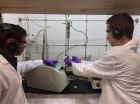(Press-News.org) August 13, 2014 – As effective treatments for HIV become more widely available in low- and middle-income countries, there's an urgent need to assess and manage health risks in the growing number of people living with HIV. An update on non-communicable diseases (NCDs) among HIV-positive populations in LMICs appears as a supplement to in JAIDS: Journal of Acquired Immune Deficiency Syndromes. The journal is published by Lippincott Williams & Wilkins, a part of Wolters Kluwer Health.
In an introductory article, Dr K.M. Venkat Narayan of Rollins School of Public Health, Emory University, Atlanta, and colleagues outline a research and capacity-building agenda to better understand and meet the challenge of NCDs in the growing number of people living with HIV in Sub-Saharan Africa and other parts of the world. They write, "Strengthening in-country research capacity in targeted areas…must be a high priority."
Research and Planning to Meet Health Needs of People Living with HIV
Large-scale HIV treatment and prevention programs have substantially lowered the rates of HIV infection and deaths from HIV/AIDS. Dr Narayan and coauthors write, "Today, with over 35 million people living (and aging) with HIV and over two million becoming infected every year, we are faced with a new challenge: addressing morbidity and mortality from NCDs—heart disease, stroke, diabetes and metabolic complications, renal disease, cancers, liver disease, and mental illness—that increase with age and may be related to HIV and its treatment."
In most low- and middle-income countries, increased availability of HIV care has not been accompanied by parallel services for NCDs, leading to preventable, premature illness and death. Rising NCD rates threaten to set back, or even reverse, the impressive health gains in HIV-infected populations.
The new supplement to JAIDS grew out of a 2013 conference of international experts, hosted by the Fogarty International Center and the Office of AIDS Research and jointly chaired by Dr Sten Vermund of Vanderbilt University School of Medicine and Dr Narayan. After the meeting, scientists from the United States and from low- to middle-income countries collaborated on a series of articles surveying the current scientific landscape of HIV and NCDs, as well as the research and training needs to address this critical issue.
The special issue addresses specific types of NCDs, including cancers; kidney and genitourinary diseases; metabolic and bone disorders; cardiovascular and pulmonary diseases; mental health, neurological diseases, and substance use; and gastrointestinal, liver, and nutrition problems. Other topics include key issues related to research methods and cost-effectiveness of setting up programs to address NCDs. In addition, two expert commentaries present the perspective of Latin American and Asian countries. The open access supplement is available at http://www.JAIDS.com.
In their introduction, Dr Narayan and colleagues outline a set of research priorities to manage the challenges of NCDs in HIV-positive populations, addressing the areas of public health surveillance and clinical epidemiology, basic and clinical research, implementation science and health systems, and infrastructure training, capacity, and workforce development. They write, "In a time of scarce resources, imaginative enhancement of HIV research and care platforms and expanded training for researchers and providers can strengthen health systems and improve the overall care of persons living with HIV/AIDS."
In the long term, investment in the training of promising scientists from low- and middle-income countries— is viewed as a "transformative" part of strategies to address the changing needs of those infected with HIV according to a preface by Dr Roger I. Glass, Director of the Fogarty International Center. He writes, "The papers in this supplement…articulate an agenda from which we can begin to address the spectrum of research, training, effective implementation, and evidence-based policy needed to confront this new challenge" of HIV and NCD comorbidities.
INFORMATION:
To read the supplement, click here.
About JAIDS
JAIDS: Journal of Acquired Immune Deficiency Syndromes is the trusted, interdisciplinary resource for HIV- and AIDS-related information with a strong focus on basic science, clinical science, and epidemiology. Co-edited by the foremost leaders in clinical virology, molecular biology, and epidemiology, JAIDS publishes vital information on the advances in diagnosis and treatment of HIV infections, as well as the latest research in the development of therapeutics and vaccine approaches. This ground-breaking journal brings together rigorously peer-reviewed articles, reviews of current research, results of clinical trials, and epidemiologic reports from around the world.
About Wolters Kluwer Health
Wolters Kluwer Health is a leading global provider of information, business intelligence and point-of-care solutions for the healthcare industry. Serving more than 150 countries worldwide, clinicians rely on Wolters Kluwer Health's market leading information-enabled tools and software solutions throughout their professional careers from training to research to practice. Major brands include Health Language®, Lexicomp®, Lippincott Williams & Wilkins, Medicom®, Medknow, Ovid®, Pharmacy OneSource®, ProVation® Medical and UpToDate®.
Wolters Kluwer Health is part of Wolters Kluwer, a market-leading global information services company. Wolters Kluwer had 2013 annual revenues of €3.6 billion ($4.7 billion), employs approximately 19,000 people worldwide, and maintains operations in over 40 countries across Europe, North America, Asia Pacific, and Latin America.maintains operations in over 40 countries across Europe, North America, Asia Pacific, and Latin America. Wolters Kluwer is headquartered in Alphen aan den Rijn, the Netherlands. Its shares are quoted on Euronext Amsterdam (WKL) and are included in the AEX and Euronext 100 indices. Wolters Kluwer has a sponsored Level 1 American Depositary Receipt program. The ADRs are traded on the over-the-counter market in the U.S. (WTKWY).
Follow our official Twitter handle: @WKHealth.
With advances in HIV care, survivors face other disease risks
JAIDS supplement focuses on non-communicable diseases in the era of effective HIV treatment
2014-08-13
ELSE PRESS RELEASES FROM THIS DATE:
Bacteria growing less susceptible to common antiseptic
2014-08-13
CHICAGO (August 13, 2014) – Bacteria that cause life-threatening bloodstream infections in critically ill patients may be growing increasingly resistant to a common hospital antiseptic, according to a recent study led by investigators at Johns Hopkins. The study was published in the September issue of Infection Control and Hospital Epidemiology, the journal of the Society for Healthcare Epidemiology of America.
Chlorhexidine gluconate (CHG) has been increasingly used in hospitals in light of recent evidence that daily antiseptic baths for patients in intensive care units ...
Care facility choice after hospital discharge about more than location, location, location
2014-08-13
INDIANAPOLIS -- Twenty-first-century patients typically don't stay in the hospital until they are completely well or totally healed. As hospitalization durations decrease, a significant number of older patients -- about one in five -- are discharged to skilled nursing facilities for continuation or closure of their care.
Deciding on the right post-discharge rehabilitation destination is important to future health and quality of life. However, it is a decision for which many patients and families are unprepared and unsupported, according to scientists from the Indiana ...
MRSA colonization common in groin and rectal areas
2014-08-13
CHICAGO (August 13, 2014) – Colonization of methicillin-resistant Staphylococcus aureus (MRSA) allows people in the community to unknowingly harbor and spread this life-threatening bacteria. The inside of the front of the nose is where this bacteria is most predominant, but new research shows nearly all colonized individuals have this bacteria living in other body sites. The study was published in Infection Control and Hospital Epidemiology, the journal of the Society for Healthcare Epidemiology of America.
"While people colonized with MRSA may not be sick, the bacteria ...
Henry Ford Hospital replaces heart valve outside the heart
2014-08-13
VIDEO:
Henry Ford Hospital cardiologist William O'Neill, M.D., Medical Director for the Henry Ford Center for Structural Heart Disease discusses the non-surgical procedure -- the first in the United States --...
Click here for more information.
DETROIT – For the first time in the United States, doctors at Henry Ford Hospital used a minimally invasive procedure to replace a failing, hard-to-reach heart valve with a new one – and placed it just outside the heart.
Due to prior ...
Morphological changes of GnRHR neurons in the rat preoptic area across puberty
2014-08-13
Gonadotropin-releasing hormone (GnRH) neurons in the preoptic area may undergo morphological changes during the pubertal period when their activities are upregulated. To clarify the regulatory mechanism of puberty onset, Dr. Quan Liu and co-workers from the First Hospital of Jilin University, China investigated the morphological changes of GnRH neurons in the preoptic area of GnRH-enhanced green fuorescent protein transgenic rats. Under confocal laser microscopy, pubertal GnRH neurons exhibited an inverted Y distribution pattern. Prepubertal GnRH neurons were generally ...
Treating Alzheimer's disease with Yizhijiannao granules by inhibiting neuronal apoptosis
2014-08-13
Previous studies have shown that Yizhijiannao granule can enhance cognitive performance in Alzheimer's disease patients and Alzheimer's disease-model mice. Further studies revealed that Yizhijiannao granule may exert its therapeutic effect by inhibiting neural cell apoptosis, reducing tau phos-phorylation and relieving neuroinflammation. Dr. Hong Zhu and colleagues who come from Third Xiangya Hospital of Central South University, China treated senescence-accelerated mouse prone 8 mice with Yizhijiannao granule, aiming to identify target-proteins of Yizhijiannao granule ...
Stem cell therapy for central nerve system injuries: Glial cells hold the key
2014-08-13
Mammalian adult central nerve system (CNS) injuries are devastating because of the intrinsic difficulties for effective neuronal regeneration. The greatest problem to be overcome for CNS recovery is the poor regeneration of neurons and myelin-forming cells, oligodendrocytes. Endogenous neural progenitors and transplanted exogenous neuronal stem cells can be the source for neuronal regeneration. However, because of the harsh local microenvironment, they usually have very low efficacy for functional neural regeneration which cannot compensate for the loss of neurons and oligodendrocytes. ...
Eco-friendly 'pre-fab nanoparticles' could revolutionize nano manufacturing
2014-08-13
AMHERST, Mass. – A team of materials chemists, polymer scientists, device physicists and others at the University of Massachusetts Amherst today report a breakthrough technique for controlling molecular assembly of nanoparticles over multiple length scales that should allow faster, cheaper, more ecologically friendly manufacture of organic photovoltaics and other electronic devices. Details are in the current issue of Nano Letters.
Lead investigator, chemist Dhandapani Venkataraman, points out that the new techniques successfully address two major goals for device manufacture: ...
What are the advantages of being married to a physician?
2014-08-13
ANN ARBOR, Mich. – Physicians tend to marry later and their marriages last longer even as they face the challenges, like others with demanding professions, of giving time and attention to their partners and families.
The University of Michigan Medical School interviewed physicians and spouses to learn how "medical marriages" succeed and the resulting report is rich with data and anecdotes about live-in in-laws, role definition, financial security and the advantage of avoiding the emergency room because Mom or Dad knows how to stitch a bad cut.
Published by the Association ...
HPV vaccine could 'close the gap' on Indigenous health
2014-08-13
In the most comprehensive assesment of its type, UNSW Australia-led research has found that in just four years, the HPV vaccine has resulted in a dramatic drop in genital warts in young Australians from a range of backgrounds, a result that could herald further good news for cervical cancer rates in future.
The research, which was done in collaboration with the University of Sydney, is based on national hospital admission rates and shows a similar result in the female Indigenous population, which has historically had significantly higher rates of cervical cancer. Genital ...
LAST 30 PRESS RELEASES:
Making lighter work of calculating fluid and heat flow
Normalizing blood sugar can halve heart attack risk
Lowering blood sugar cuts heart attack risk in people with prediabetes
Study links genetic variants to risk of blinding eye disease in premature infants
Non-opioid ‘pain sponge’ therapy halts cartilage degeneration and relieves chronic pain
AI can pick up cultural values by mimicking how kids learn
China’s ecological redlines offer fast track to 30 x 30 global conservation goal
Invisible indoor threats: emerging household contaminants and their growing risks to human health
Adding antibody treatment to chemo boosts outcomes for children with rare cancer
Germline pathogenic variants among women without a history of breast cancer
Tanning beds triple melanoma risk, potentially causing broad DNA damage
Unique bond identified as key to viral infection speed
Indoor tanning makes youthful skin much older on a genetic level
Mouse model sheds new light on the causes and potential solutions to human GI problems linked to muscular dystrophy
The Journal of Nuclear Medicine ahead-of-print tip sheet: December 12, 2025
Smarter tools for peering into the microscopic world
Applications open for funding to conduct research in the Kinsey Institute archives
Global measure underestimates the severity of food insecurity
Child survivors of critical illness are missing out on timely follow up care
Risk-based vs annual breast cancer screening / the WISDOM randomized clinical trial
University of Toronto launches Electric Vehicle Innovation Ontario to accelerate advanced EV technologies and build Canada’s innovation advantage
Early relapse predicts poor outcomes in aggressive blood cancer
American College of Lifestyle Medicine applauds two CMS models aligned with lifestyle medicine practice and reimbursement
Clinical trial finds cannabis use not a barrier to quitting nicotine vaping
Supplemental nutrition assistance program policies and food insecurity
Switching immune cells to “night mode” could limit damage after a heart attack, study suggests
URI-based Global RIghts Project report spotlights continued troubling trends in worldwide inhumane treatment
Neutrophils are less aggressive at night, explaining why nighttime heart attacks cause less damage than daytime events
Menopausal hormone therapy may not pose breast cancer risk for women with BRCA mutations
Mobile health tool may improve quality of life for adolescent and young adult breast cancer survivors
[Press-News.org] With advances in HIV care, survivors face other disease risksJAIDS supplement focuses on non-communicable diseases in the era of effective HIV treatment





